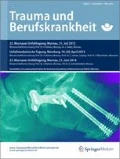Zusammenfassung
Eine Frakturklassifikation ist Grundlage der Erfassung epidemiologischer und klinischer Frakturdaten in einer systematischen einheitlichen Dokumentation und damit auch Grundvoraussetzung zur Evaluierung diagnostischer und therapeutischer Maßnahmen im Sinne einer Effizienz- und Effektivitätskontrolle. Mit der AO-Fraktur-Klassifikation des Erwachsenen konnten zwar auch bezüglich kindlicher Frakturen Erkenntnisse gewonnen werden, dennoch ist diese Einteilung nicht unverändert auf Brüche des wachsenden Skelettes übertragbar, da sowohl das Verletzungsmuster als auch Therapie und Outcome vom Alter und Reifestadium der Wachstumsfugen abhängen. Jüngst wurden 2 systematische kinderspezifische Klassifikationen erarbeitet und validiert, die Klassifikation der AO Paediatric Expert Group (PAEG) wird im vorliegenden Beitrag vorgestellt. Der vollständige Frakturkode wird aus 5 (Knochen-, Segment-, Typ-, Kinder- und Frakturschwerekode) bzw. 6 Kodes gebildet, in Abhängigkeit davon, ob ein Ausnahme- bzw. Zusatzkode angewendet wird.
Abstract
A fracture classification forms the basis for compiling epidemiological and clinical fracture data in systematic and standardized documentation, thus forming the basic requirement for any evaluation of diagnostic and therapeutic measures in order to monitor efficiency and effectiveness. Information relating also to pediatric fractures can be gained using the AO fracture classification for adults, although this cannot be directly extrapolated to the growing skeleton, since injury patterns, therapy and outcome depend on growth plate age and stage of maturity. Two child-specific classifications have recently been compiled and validated; one of these, the AO of the Paediatric Expert Group (PAEG) is presented here. The complete fracture code comprises between five (bone, segment, type, child and severity) or six codes, depending on whether an exception is made or an extra code is used.









Literatur
Laer L von, Gruber R, Dallek M et al (2000) Classification and documentation of children’s fractures. Eur J Trauma 26:02–14
Müller ME, Nazarian S, Koch P, Schatzker J (1990) The comprehensive classification of fractures of long bones. Springer, Berlin Heidelberg New York
Slongo T, Audigé L (2007) Fracture and dislocation classification compendium for children. The AO Pediatric Comprehensive Classification of Long Bone Fractures (PCCF) on behalf of the AO Pediatric Classification Group. J Orthop Trauma [Suppl] 21:S135–S160
Slongo T, Audigé L, AO Pediatric Classification Group (2007) AO pediatric comprehensive classification of long-bone fractures (PCCF). Brochure AO Education. AO Publishing, Dübendorf
Slongo T, Audige L, Clavert JM et al (2007) The AO comprehensive classification of pediatric long-bone fractures. A web-based multicenter agreement study. J Pediatr Orthop 27:171–180
Danksagung
Unseren Dank an Herrn Dr. Slongo und Herrn Audigé für Ihre Genehmigung, die Abbildungen aus ihrer Arbeit [4] benutzen zu dürfen.
Author information
Authors and Affiliations
Corresponding author
Ethics declarations
Interessenkonflikt
Der korrespondierende Autor gibt an, dass kein Interessenkonflikt besteht.
Rights and permissions
About this article
Cite this article
Fernandez, F.F., Eberhardt, O. Klassifikationen von Frakturen im Kindesalter. Trauma Berufskrankh 21 (Suppl 1), 65–73 (2021). https://doi.org/10.1007/s10039-020-00464-2
Published:
Issue Date:
DOI: https://doi.org/10.1007/s10039-020-00464-2

